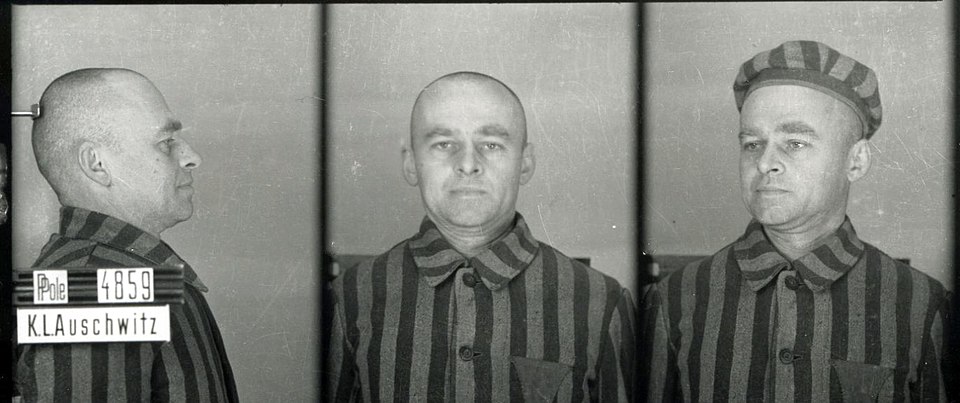Witold Pilecki in Auschwitz: voluntary infiltration, resistance and escape (1940–1943)
Witold Pilecki in Auschwitz — a concise, sourced overview of how a Polish resistance officer volunteered to be deported to the camp in 1940, organised an underground network, smuggled intelligence reports, and escaped in 1943. For origins of the site see The Origins of Auschwitz; for the layout and functions of the complex see Auschwitz map and structure and Auschwitz Birkenau; for clandestine activity more broadly see Auschwitz resistance.
Key facts
- Identity: Witold Pilecki (false name at arrest: Tomasz Serafiński)
- Arrival: September 1940, prisoner no. 4859
- Underground: founded ZOW (Związek Organizacji Wojskowej)
- Intelligence: reports smuggled to the Polish underground and Allies
- Escape: night of 26–27 April 1943 from a work assignment outside the main fence
- After Auschwitz: continued resistance; executed by the communist regime in 1948
Witold Pilecki in Auschwitz: volunteering to infiltrate (1940)
In 1940 Pilecki, a cavalry officer and member of the Polish underground, took part in a plan to infiltrate the new German camp at Oświęcim. Using a false identity, he allowed himself to be caught in a Warsaw roundup so that he would be sent to the camp. In September 1940 he arrived as prisoner no. 4859. For Witold Pilecki in Auschwitz the mission meant building aid and information flows from inside a system designed to isolate prisoners completely, while keeping the network compartmentalised for safety.
Building the underground: ZOW inside Auschwitz
Once inside, Pilecki established the Związek Organizacji Wojskowej (ZOW), a clandestine network built in small cells to minimise risk. The goals were to boost morale, share food and information, record transports and deaths, and prepare for a possible uprising if the front drew near. The network cultivated contacts across work details, which was essential for gathering data and smuggling messages. In practice, Witold Pilecki in Auschwitz meant daily, low-visibility cooperation: memorising facts from different kommandos, passing notes at great risk, and protecting sources if a roundup or interrogation occurred.
Reports compiled under Pilecki’s leadership were carried beyond the camp by prisoners released, transferred or escaped. These early accounts helped shape the outside world’s understanding of the camp’s structure, terror and the escalating persecution of Jews and other victim groups. For broader victim numbers and sources see Victims and Survivors of Auschwitz.

Informing the outside world: early Auschwitz reports
From late 1940 onward, information gathered by ZOW was transmitted to the Polish underground and, via couriers, reached the Allies. These dispatches—later followed by reports from escapees—were among the first systematic descriptions of Auschwitz available outside occupied Poland. Witold Pilecki in Auschwitz is therefore also a story of method: cross-checking rumours, noting arrivals, names and numbers, and converting individual observations into reports that decision-makers could trust. For institutional context see the museum page Reports by Auschwitz escapees and the USHMM encyclopedia entry on Witold Pilecki.
Escape and continued resistance (April 1943)
On the night of 26–27 April 1943 Pilecki escaped with two fellow prisoners during a work assignment outside the main fence. After reaching resistance contacts, he compiled a fuller account of the camp and argued for a possible operation against the site. He continued underground activity; later he fought in Warsaw and, after the war, was arrested by the communist authorities. The trajectory underlines why historians still study Witold Pilecki in Auschwitz: the mission linked prisoner aid, intelligence-gathering and post-escape testimony into one coherent effort.
Legacy and remembrance
Pilecki’s decision to enter Auschwitz voluntarily, organise resistance, and bear witness has made him one of the most widely cited figures in studies of the camp. His reports and post-escape writings remain essential to understanding how information about the camp reached the outside world. Memorial projects, scholarly biographies and museum exhibitions continue to revisit his role, placing it alongside other forms of clandestine activity described in our guide to Auschwitz resistance. For the end of the camp’s history see When was Auschwitz liberated?.
Read next
Auschwitz resistance · Origins of Auschwitz · Auschwitz map and structure · Victims and Survivors
